The next stamp we expose as fake is part of the Washington / Franklin regular issue of November 1914. It has a single line watermark and is perforated 10 horizontally on a common perforation gauge. It was produced by the FLAT PLATE press printing method, and popped out of the presses in sheets of 400 subjects in 4 panes of 100.
Fakes of the flat plate press coils are probably the most commonly altered stamps because genuine copies in mint F-VF condition of certain issues command very high prices.
The method described in this article only applies to fake coils made from booklet panes. I am sure in the next few weeks I will find some other variations and I will share them with you then.
New Rev5.1 Design, November 2007
Buy the Sonic Imagery Labs Specialty Perforation & Grill Multi -Gauge
Download Instruction Sheet for the Sonic Imagery Labs Specialty Perforation & Grill Multi -Gauge
Download a MAIL ORDER form for the Sonic Imagery Labs Specialty Perforation & Grill Multi -Gauge
Another Bogus Scott 519 - New November 2002
The Fake Scott 346 Private Perf - New October 2002
The Most Impressive Fake Scott 62B
The Secret Life of an Altered Scott 72
The Secret Life of a Chemically Altered Scott 78
The Secret Life of an Altered RW5 Duck Stamp
A Fake Scott #320 with Schermack Type III Perforations
Fake Scott #743a
Detecting a Flat Plate Press Vertical Coil, Fake Scott 441
Fake Reperfed 514a
Fake Reperfed 508c
Fake Reperfed 546
Fake Scott 143 w / Bogus Grill
Fake Scott 137 w / Same Bogus Grill as Fake 143
Fake Scott 139 w / Same Bogus Grill as Fake 137 and 143
Fake Scott 315 - Revised June 2002
Fake Reperfed Scott 519 - Revised June 2002
A Gallery of Bogus Stuff Part 1
A Gallery of Bogus Stuff Part 2
A Gallery of Bogus Stuff Part 3
A Gallery of Bogus Stuff Part 4
A Gallery of Bogus Stuff Part 5
Credits, Inspiration and Links of Interest
Bibliography of Research Material I Use for this Site
Download the Schermack Type III Go-NoGo Gauge
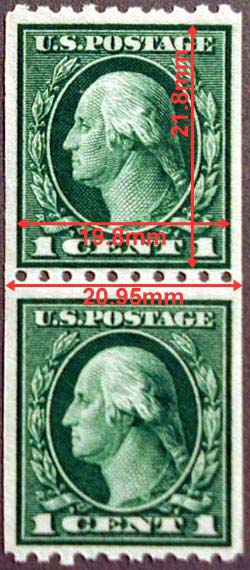
This was purchased so long ago that I am only a little bit mad about it. It's not a particularly valuable specimen. I guess, I would say that I am disappointed because, I have to now go find a genuine pair to fill the empty Showguard mount in my book. UUuuggghh! I hate it when that happens. And happens it does.
Specifications of a genuine Scott 441:
Color: Green or Deep Green
Perforation:
10 horizontally on a common gauge
10-79 using a "Specialist Gauge"
9.97 using a "Linns or "Instanta" gauge
Single Line Watermark. Scott Wmk 190
Engraving Design Type: Flat Plate, No special variation
Design Size: 19 mm wide by 22.0 mm ± 0.3 mm
Straight edge width: 21.5 mm
Gather the facts:
When I receive a coil pair I get my handy notebook and gather the facts. The picture on the left has some of my notes already on it for you. Here is what we know as fact so far.
Evidence:
Fact 1. The design measures 19.8 mm by 21.8 mm. This means it is indeed a flat plate press stamp
Fact 2. The edge to edge width measures 20.95 mm. This is cause for alarm, as it is 0.55 mm on the narrow side.
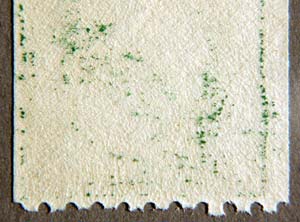
Gather more evidence:
When flat plate press stamps are produced, they leave the press as a sheet. The sheet drops on to the previous sheet of freshly printed stamps. Then the next is printed. And so on and so forth. The aniline ink used during manufacture doesn't dry instantly. In the image to the left, you can see the wet ink from the previously printed sheet got on the back of our subject stamp. This characteristic only shows on flat plate press stamps. It is an excellent way to determine that what you are looking at is indeed a flat plate printing.
Fact 1. The design measures 19.8 mm by 21.8 mm. This means it is indeed a flat plate press stamp. The ink on the back of the stamp verifies our evidence.
Fact 2. The edge to edge width measures 20.95 mm. This is cause for alarm, as it is 0.55 mm on the narrow side.
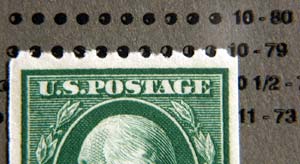
Gather more evidence:
The specialist gauge measures that the perforations are 10-79. That second number means that the perforation holes are separated by 0.079 inches. That's 79 thousandths of an inch. In the image to the left, it appears the holes are the proper diameter and they gauge correctly in the horizontal axis.
Fact 1. The design measures 19.8 mm by 21.8 mm. This means it is indeed a flat plate press stamp. The ink on the back of the stamp verifies our evidence.
Fact 2. The edge to edge width measures 20.95 mm. This is cause for alarm, as it is 0.55 mm on the narrow side.
Fact 3. The perforations gauge correctly for the issue.

Gather more evidence:
The white arrows are pointing to the little tufts of paper fiber on the left side of the hole. This is a genuine artifact of the rotary perforation process. These fibers should always be present on the same side of the perforation holes, and indicate that the sheet was fed into the perforation machine from the right side. This strengthens the evidence for fact number 3.
Fact 1. The design measures 19.8 mm by 21.8 mm. This means it is indeed a flat plate press stamp. The ink on the back of the stamp verifies our evidence.
Fact 2. The edge to edge width measures 20.95 mm. This is cause for alarm, as it is 0.55 mm on the narrow side.
Fact 3. The perforations gauge correctly for the issue. The presence of fiber within the holes adds credence that the perforations are indeed genuine.
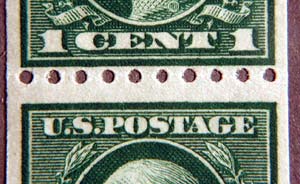
Here is a closer view at 30X magnification. Let's deal with fact 2 now. Fake coils, made by trimming genuine sheet stamps, or booklet panes, are difficult to detect, since the perforation holes are genuine in all respects. Therefore, the unperforated edge of the coil should be examined carefully and closely. To say that a genuine coil has a look and feel to the edge which is difficult to fake is a true statement, but is not very helpful to the examiner or collector. The edges of a genuine coil have a softness and shape to them which have resulted from age and handling and from their being cut with a circular rotating blade. Fakes cut with an xacto knife or razor blade simply do not look or feel the same.
How we first caught this as being bogus is that vertical coils generally measure 21.5 mm edge to edge. Our suspect measures 20.95 mm edge to edge. The right side looks and feels very sharp and very unnaturally straight. The left edge appears and feels genuine. This is confusing at first, but more clues will help. Let's add more evidence to fact 2.
Fact 2. The edge to edge width measures 20.95 mm. This is cause for alarm, as it is 0.55 mm on the narrow side. The right vertical edge feels very sharp and square when viewed edge on and doesn't look the same as the left edge.
What we need now is a smoking gun to declare this stamp a fake.
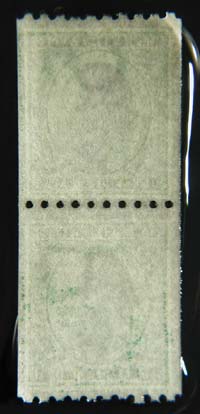
Time for a watermark check!
Watermarking is my favorite thing to do. Look at the image to the left. The top stamp shows the single line "S" watermark. The lower stamp has the "P" watermark. The "P" and the "S" are lying on their sides, or they "read" vertically.
THIS IS OUR SMOKING GUN! This stamp was made from a booklet pane. Genuine coils made from flat plate pressings have only watermarks that "read" horizontally. We now have enough information to determine what this stamp really was.
Facts in evidence:
Fact 1. The design measures 19.8 mm by 21.8 mm. This means it is indeed a flat plate press stamp. The ink on the back of the stamp verifies our evidence.
Fact 2. The edge to edge width measures 20.95 mm. This is cause for alarm, as it is 0.55 mm on the narrow side. The right vertical edge feels very sharp and square when viewed edge on and doesn't look the same as the left edge.
Fact 3. The perforations gauge correctly for the issue. The presence of fiber within the holes adds credence that the perforations are indeed genuine.
Fact 4. Genuine coils made from flat plate pressings have only watermarks that "read" horizontally. Our stamps watermark "reads" vertically. It stands to reason that the forger made this from some other single line watermarked, perf 10 variety.
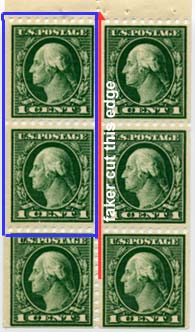
Conclusion:
I whipped out my other most favorite book. The Experts Book, A Practical Guide to the Authentication of United States Stamps, Washington/Franklin Issues 1908-1923, by Paul Schmid, 1990. I wanted to figure out what booklet pane was used to create this fake and which position of the booklet was used.
The Experts Book states that fake 441's are made by trimming either the left or right sides of a 424d. In our case the upper left hand pair was removed from the booklet and the right edge was trimmed.
The red line illustrates the edge that was trimmed. The blue box is the position in the booklet pane that our fake was from.
Rarity and demand notwithstanding, there is a huge number of low to mid value altered and fake stamps in the market today. Armed with knowledge and the ability to research, most fakes and forgerie's can be detected by an informed amateur. One only needs a millimeter gauge, a good magnifier and an analog perforation gauge.
Thanks for visiting this site. I hope you learn something new as I am having fun doing this and stirring up the "doodoo" so to speak. You, the visitor, have my permission to copy my pages and images for the purpose of showing others how to look for fakes and forgeries. You also have my permission to link to my pages and to share the link paths to others. I only ask in return for you to send me an e-mail if I have made a mistake or have done some other technical blunder that in my rush to put these pages up would cause the visitor confusion. Please also visit my other website www.slingshotvenus.com and support the live music arts.
In the next few weeks and months I will be adding more images and words for a whole bunch of fakes I have purchased on Ebay and since I am not worried that the fakers will retaliate I will even tell you who they are. This is installment number 13 so come back and visit as I will probably be doing 1 or 2 new pages each week. I can be reached at: nerdman@ix.netcom.com